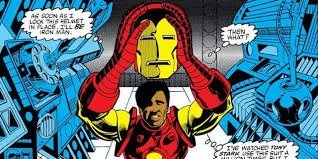New Faces, Old Masks
Venom never actually replaced Peter Parker as Spider-Man; it would only be in the nineties that the convoluted Clone Saga pushed Peter into temporary retirement. But between the symbiote's function as Spider-Man's black costume and Venom's role as the hero's monstrous, distorted reflection, the storyline fit within the larger dynamics going on at Marvel in the 1980s: the (always temporary) passage of the hero's mantle to a new character.
This was not a new trope for superhero comics. Captain America in particular was prone to replacements. When Steve Englehart was writing the book, Steve Rogers briefly gave up being Captain America after Watergate, with two other men substituting for him. Englehart also introduced a retcon explaining away Captain America's adventures in the 1950s, when he was supposed to be on ice: the government replaced the missing Cap and Bucky with two eager young men who would be rendered mentally unstable by an imperfect super-soldier serum. Nor was this the only new Bucky; when Captain America awoke from suspended animation, he mistook young Rick Jones (the Hulk's former sidekick) for his dead partner. In what now looks like a disturbing turn of events, Cap could not let this coincidence go, first training Rick and then actually giving him a Bucky costume. [1]
Given Shooter's demands that Doug Moench kill off Shang-Chi's entire cast, turn him into a villain, and replace him with a new Master of Kung-Fu, it should not come as a surprise that replacement heroes proliferated at Marvel in the 1980s. When Tony Stark falls off the wagon, his best friend Rhodey becomes the new Iron Man, although he lets the rest of the Avengers think that he is still the man who was originally inside the armor. Thor's hammer is wrested from him by the horse-headed alien called "Beta Ray Bill," making him the new Thor for a few issues. Captain America is replaced by the ultraconservative patriot John Walker and She-Hulk takes over for the Thing in the Fantastic Four. In all of these case, the series eventually, and unsurprisingly, revert to the norm, but not before they have done their job in expanding their headliner's world. When Tony Stark returns, Rhodey gets a new suit of armor and takes on the name "War Machine." Beta Ray Bill is given a hammer of his own by Odin, and becomes a recurring character in Thor's comic. After Steve Rogers takes back his shield, John Walker becomes the USAgent. The Fantastic Four continued Roger Stern's effort to build up the popularity of She-Hulk; her departure from that book facilitated Byrne's next project, a solo Sensational She-Hulk title that stood out for its lighthearted approach and frequent breaking of the fourth wall.
Hey, kids! Let’s call this “woke” and get angry!
When Shooter returned to The Avengers 211 (with art by Gene Colan and Dan Green, September 1981), he shook up the roster more drastically than anyone had in a decade and a half. Avengers mainstays The Vision and the Scarlet Witch leave the book, along with Wonder Man and the Beast, who had been central to the cast for half a decade. Only a few years later, a group of current and former team members were spun off into West Coast Avengers (later retitled Avengers West Coast).
Finally, the status quo for the Hulk would change repeatedly throughout the decade, but his identity was already more complicated than that of the aforementioned costumed heroes. When Bruce Banner is exposed to the energy released by his Gamma Bomb, the profound and periodic changes in his body are not at first accompanied by as stark a change in his mind. The initial series ran for only six issues before its cancellation (1963-1964); it was only after his appearance in the first two issues of The Avengers, his guest appearances in Fantastic Four and The Amazing Spider-Man, and his earliest adventures in Tales to Astonish (staring with issue 60 in 1964) that he somehow lost the ability to use personal pronouns and express complex thoughts. After Hulk settles into his childlike, cognitively limited persona, and after the mechanism for transformation from Banner to Hulk has become firmly associated with a loss of temper (as opposed to the early issues, when Bruce became the Hulk at sundown), the comic has wholeheartedly adopted the Jekyll/Hyde model. The Hulk is not so much Bruce’s dark side, since he is not evil, as he is the embodiment of Bruce Banner’s suppressed rage.
Next: You Wouldn't Like Me
Note
[1] Susan Richards was also frequently replaced before the 1980s, initially because of her pregnancy with Franklin.
